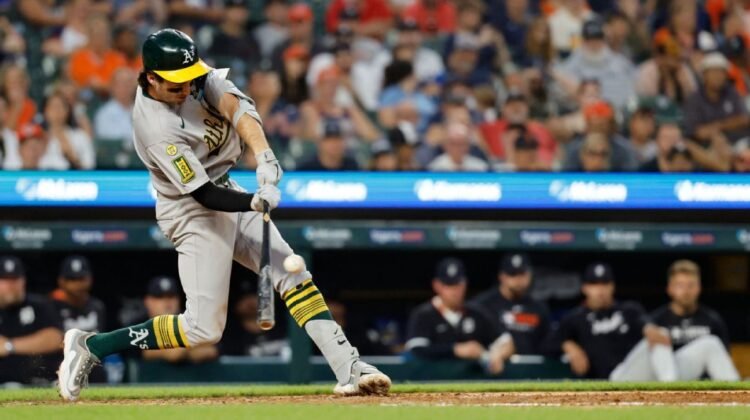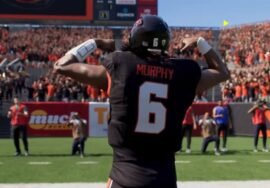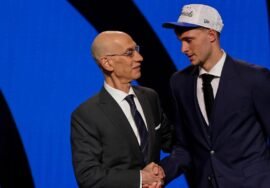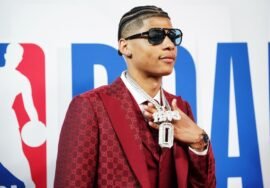
Inside A’s shortstop Jacob Wilson’s path to MLB stardom
Warning: What you’re about to read is Jacob Wilson’s opinion. He is a professional baseball player — a very good one — and not a medical expert, but there are some things he is convinced are true, and this is one of them.
The 23-year-old Wilson, the Athletics’ wunderkind shortstop, is wise enough to understand that the sort of success he has found on the baseball field — a .347 batting average and a near-certain invitation to the All-Star Game coming — comes from a multitude of areas. He is the son of a longtime big leaguer, so certainly genetics helped, and he works relentlessly at his craft, which goes a long way. But the special sauce that built the American League Rookie of the Year favorite, he believes, included a secret ingredient.
Fortnite.
“Kids are going to love this one. Parents are going to hate me,” Wilson said. “I am a big believer in video games. It’s fast decision-making strategy. I think that gets me ready for the game, because when you’re in the box, you have to process a lot. So there’s some days where I’ll wake up and I’ll play video games and then I’ll go to the field, and I’ll have a good day. Some days I won’t play and don’t see the ball well. I think it really helps me train kind of the decision-making that I have to make six, seven hours later at the baseball field.”
Yes, one of the best hitters in the major leagues, a contact maven who strikes out with the infrequency of Tony Gwynn, swears that he’s as good as he is at a kid’s game because of his aptitude at another kid’s game. After Wilson wakes up, he deploys to his living room and parks in a chair. On the table in front of him sits a PC and controller. He logs in to Fortnite — the eight-year-old game still played by millions every day — hops on the Battle Bus and systematically disposes of those with the misfortune of sharing a map with him.
“If we play a game with me and him and guys we know and you kill him once, you’re like, ‘That’s a good day,'” A’s infielder Max Muncy said. “You could play 50 rounds. Just once is good.”
Muncy has known of Wilson’s Fortnite exploits since they were teammates at Thousand Oaks (California) High, where Wilson’s father, former Pittsburgh shortstop Jack Wilson, coached. Back then, Jack actually questioned whether the game was interfering with Wilson’s baseball growth — though he understood Wilson’s reasoning. Over his 12-year big league career, Jack earned a reputation as one of the best ping-pong players in the major leagues. It was pure reaction, not unlike hitting, and he complemented his pregame work in the batting cage with the brain training found in a paddle and hollow ball.
He saw the same opportunity in video games for his son — with a caveat.
“I do believe in the hand-eye coordination that video games give — as long as you do your homework,” Jack said. “Kids, if you’re reading, do your homework.”
The Wilsons are not alone in their belief that unconventional methods off the field can lead to success on it. Studies back up the suggestion that video games can be beneficial for brain activity. And considering the recognition being lavished on Wilson — he is more than a quarter-million votes ahead of Kansas City star Bobby Witt Jr. in All-Star balloting to be the American League’s starting shortstop — the benefits are pronounced.
Of course, dropping in to Anarchy Acres does not a big league hitter make. The story of Wilson’s ascent actually starts in his backyard, where he spent countless hours figuring out how to thrive in a game that simply isn’t built for hitters like him anymore.
Heaven for the Wilson family is a regulation-sized turfed infield with a FungoMan ground ball machine, a fence covered with famous retired numbers and stadium logos, a full dugout on the third-base side — and a grill stationed in center field in case someone gets hungry. The backyard of the family’s home is a testament to form and function, and it’s where Jacob learned how to be — and how not to be — like his father.
“It was a place built for guys who just love the grind of wanting to get better every day,” Jack said.
Jack’s bat was never as adapt as his glove, and to last a dozen years in the big leagues, he needed countless reps to keep his fielding at a level that, according to Baseball-Reference, produced the fifth most defensive wins above replacement this century, behind only Andrelton Simmons, Yadier Molina, Adrian Beltre and Kevin Kiermaier.
“You know that idea about being able to write a letter to your former self on what would you tell yourself now?” Jack said. “I get to do that with Jake. And I said, ‘You know, this is the way I hit. I don’t want you to hit like this.’ Because there were so many things I wish I could have done differently. If I were to build a perfect hitter, what would I do?”
He started with Miguel Cabrera. Wilson always admired how tall he stood in the batter’s box before sinking into his legs. Then it was Mike Trout. The simplicity of his swing has always been a marvel, but in particular Wilson appreciated the speed at which he loads his hands, allowing Trout to be on time even for 100 mph fastballs. The final lesson was Albert Pujols’ bat path, which was so flat and stayed in the zone for so long it allowed him to sting the ball from foul pole to foul pole while maintaining strikeout numbers that were well below league average.
To hone that Voltron of a swing, a teenage Wilson would grip a custom wood bat with a 1½-inch barrel — an inch less than a standard big league barrel — and face his dad, who stood 45 feet away and ripped 85 mph fastballs and sliders using a tennis ball. If Wilson didn’t catch the ball on the meat of the barrel, it would spin sideways, forcing him to learn to maneuver his bat with special dexterity.
The skinny bat made a regulation-sized model feel twice as big. When he took regular batting practice, Wilson always started by peppering the right side of the field on his first dozen swings. Even though Wilson was bigger than his father — at 6-foot-3, he is a comparatively imposing presence — Jack didn’t want him to fall into the trap of always trying to pull the ball. While that approach works for some hitters, Cabrera, Trout and Pujols embraced and embodied an all-fields approach.
By Wilson’s junior year in high school, the work started to pay off. Wilson didn’t strike out once all season. He didn’t punch out during his COVID-shortened senior season, either, and continued that trend at Grand Canyon University in Phoenix, where his sophomore year he whiffed seven times in 275 plate appearances and his junior season had five punchouts in 217 times at the plate. Twice, he received a plaque from the NCAA for being the toughest hitter to strike out in college baseball.
The A’s took Wilson with the sixth pick in the loaded 2023 draft. Last year, he hit .433/.473/.668 with just 15 strikeouts in 226 plate appearances across three minor league levels and just a year and 10 days after being drafted, he debuted in the big leagues.
In a world of launch angle and exit velocity, Wilson arrived in the majors wanting to be more like Luis Arráez and Nico Hoerner, contact artists nonpareil who value batting average and are allergic to strikeouts.
“I just take strikeouts so personally,” Wilson said. “It’s the one thing in this game that makes me more mad than anything. So I’ll go up there and I’ll swing at a pitch that’s maybe a couple inches off and take a base hit to right. So I think batting average definitely is a stat that should be seen and should matter for most hitters.”
Wilson’s swing is kinetic, with a wide-open stance that closes as he moves his legs and flaps his arms — a little Chicken Dance, a little Cabrera-Trout-Pujols. While he hasn’t always been this twitchy — “I’ve got to keep my muscles moving a little bit,” Wilson said — it works for him. Wilson keeps the knob of the bat in the direction of the ball longer than most hitters, reminding himself to “stay inside the baseball,” a lesson preached ad nauseam by Jack. Aiming to strike the inside of the ball, Wilson said, keeps him from rolling over it. He lives by the old axiom “good hitters get jammed” and doesn’t shy away from flipping a duck snort between the infield and outfield.
The approach has served him well. After starting the year in the No. 9 hole, Wilson has hit first or second every game since May 7. Only Arráez has a lower strikeout rate than Wilson’s 6.8% — and Wilson has nine home runs compared to Arráez’s one. Of all the strikeout-averse hitters in the game, the most comparable to Wilson’s.347/.388/.487 line is Cleveland third baseman Jose Ramirez, who’s primed to play in his seventh All-Star Game this season.
“It’s not even his hits,” said Nick Kurtz, the A’s first baseman and fellow rookie. “I’ve seen multiple times where there’s a sinker up and in that was going to hit him, and he hit it to second base. Sometimes they’re a hit, sometimes they’re not. Every time, though, I’m like, ‘How the hell did he do that?’ Being able to touch it, not break your bat and go the other way with it? I’m at a loss for words.”
On April 5 at 11:13 p.m., Jack Wilson’s phone dinged. He had texted his son to congratulate him on a good team win by the A’s. Wilson didn’t want to hear it. He was mad. He had gone 1-for-4 with a two-run double, but that wasn’t good enough.
“I’m not a .250 hitter,” Wilson texted.
Jack laughed. He batted .265 in his career. It was enough to earn him more than $40 million playing. His son wants to be better — not because he’s greedy but because he’s capable of it.
“That’s a good thought process,” Jack said. “Because when I was a rookie and I got a hit, I was pumped. I always tell him, ‘Man, hitting is freaking hard.’ It’s just not going to be every day where your swing is on point and you match up. It’s just the way it is. So this has been a real learning experience. And it will be for a long time. The more he learns now, the better off he is in the future and hopefully spends a long time as an Athletic.”
The A’s are counting on their star shortstop as a linchpin of their impressive offensive core. Wilson is the fulcrum, Kurtz the powerhouse with a propensity for late-inning heroics. Designated hitter Brent Rooker and outfielder Lawrence Butler are both sluggers locked up to long-term deals. First baseman Tyler Soderstrom and catcher Shea Langeliers provide additional home run thump. Denzel Clarke is going to win multiple Gold Gloves in center field. If they can build a pitching staff to match, the team scheduled to move to Las Vegas for the 2028 season will be among the most exciting in baseball.
And it all starts with the kid who is definitely not a .250 hitter and definitely does take strikeouts personally.
“I mean, I’ve studied his swing,” Muncy said. “There’s things that he does so well that other guys don’t do that leads to that. And I think one of the things is probably just his mentality. He has always thought he could put it in play. I don’t think there’s ever been a guy where he is like, ‘I can’t put it in play.’ When you have that supplemental edge — I can put it in play no matter what — that helps.”
Every edge helps, be it bat-to-ball skills, burgeoning power or the ability to no-scope someone from 300 meters. Wilson has no plans to abandon his Fortnite reps. It’s part of his training now, and even if it doesn’t work for everyone, he sees Victory Royales leading to victories for the A’s.
“Everybody has their own approach and everybody’s here for a reason,” Wilson said. “This is the big leagues. Everybody is the best in the world at what they do.”








